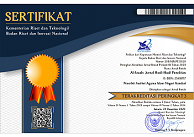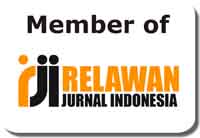PENGGUNAAN DAN PEMAANFAATAN CYBERSPACE DALAM GERAKAN PEMIKIRAN HIZBUT TAHRIR
Abstract
This research aims to analyze the use and utilization of cyberspace as new media (internet) in the movement thought of Hizbut Tahrir at IAIN Kendari. The findings of the situation show that the use and utilization of cyberspace via the internet with the Facebook as one of the social media by either students who follow the activities of the intra or extra campus or who does not enter the organization by taking samples in the first half of the even and odd semester students of 2016/2017nwhich consists of eight classes indicate that they are more panic when it comes to the use of Facebook taking up to 0.89 or 89%. From the use of this social media, then the process of movement of thought against religious doctrine can be done through cyberspace started from the ndividual level, the level of interaction between the individual and community level; cybersociety (virtual community) and finally form a culture (Cyberculture) by a movement of Hizbut Tahrir. The process of religious doctrine is done through several methods, namely: participation, openness, communication, community, dependency/connectedness.
Keywords
Full Text:
PDFReferences
An-Nabhani, Taqiyuddin. Peraturan Hidup Dalam Islam. Jakarta: HTI Press, 2001.
Alice, Tomic, Laura Lengel, & Crispin Thurlow. Computer Mediated Communication Social Interaction and The Internet. California: Sage Publications, 2004.
Azca, Muhammad Najib, “Yang Muda, Yang Radikal: Refleksi Sosiologis Terhadap Fenomena Radikalisme Kaum Muda Muslim di Indonesia Pasca Orde Baru”, Jurnal MAARIF. Arus Pemikiran Islam Dan Sosial, Vol. 8 No 1, (Juli, 2013): 14-44.
Badan Inteligen Nasional, Gerakan Islam Transnasional dan Pengaruhnya di Indonesia.
Bell, David. Cyberculture Theories: Manuel Castells and Donna Haraway. London-New York: Routledge, 2007.
Bakardjieva, Maria. Internet Society: The Internet in Every Day Life. 1 edition. California: Sage Publications Ltd, 2005.
Bungin, Burhan. Sosiologi Komunikasi Teori, Paradigma dan Diskursus Teknologi Komunikasi di Masyarakat. Jakarta: Kencana. 2006.
Castells, Manuel, The Power of Identity, Second Edition With A New Preface, Wiley-Blackwell, 2010). https://www.researchgate.net/publication/280831282_Networks_in_Manuel_Castells'_theory_of_the_network_society.
Effendi M. “Peranan Internet Sebagai Media Komunikasi”. Jurnal Dakwah dan Komunikasi, Vol. 4 No.1 (2010): 130-142.
Golose, Petrus R. Deradikalisasi Terorisme Humanis dan Menyentuh Akar Rumput. Jakarta: YPKIK, 2009.
Iqbal, Asep Muhammd. “Agama dan Adopsi Media Baru: Penggunaan Internet Oleh Gerakan Salafisme di Indonesia”. Jurnal Komunikasi Indonesia. Vol 2. No. 2 (Oktober, 2013).
Levy, Pierre Cyberculture: Electronik Mediations. V. 4, (London: University of Minnesota Press. 2001)
Ma’arif, Ahmad Syafi’i. “Masa Depan Islam di Indonesia dalam Abdurrahman Wahid (Ilusi Negara Islam). Jakarta: The Wahid Institute, 2009.
Mayfield, Antony. What is Social Media?. London: Crossing. United Kingdom, http://www.iCrossing.com/ebooks.2008.h.5
Mustaqim, Muhammad. “Pergulatan Pemikiran Islam Di Ruang Publik Maya (Analisis terhadap Tiga Website Organisasi Islam di Indonesia)”, Jurnal Penelitian, Vol. 7, No. 2, (Agustus 2013): 255-352
Poster, Mark. What’s The Matter With The Internet. Minneapolis: University of Minoseta Press.2001, h.1-20.
Pramod, Nayar K. The New Media and Cybercultures Anthology. London: John Wiley and Sons, Incorporated, 2010.
Rafta, Yuni. “Sosial Network Analysis dalam Melihat Kecenderungan Pemberitaan Pada Akun Twitter “detikcom” dan “Metro_TV”, Jurnal Khazanah. Vol 6 No. 2, (Januari 2014).
Simarmata, Salvatore. “Media Baru, Ruang Publik Baru dan Transformasi Komunikasi Politik di Indonesia”, Jurnal INTERACT, Vo.3 No.2, (November 2014): 18-36.
Wenger, E., R McDermott&W Snyder. Communities of Practice: Learning, Meaning, and Identity. (Cambridge, UK: Cambridge University Press, 2002.
Turkle, S. The Second Self: Computers and the Human Spirit. London: The MIT Press, 2005.
Winardi. Teori Organisasi dan Pengorganisasian. Ed-1-4. Jakarta: PT. Raja Grafindo Persada, 2007.
Winarni, Leni, “Media Massa dan Isu Radikalisme Islam”. Jurnal Komunikasi Massa. Vol 7. No.2, (Juli, 2014).
DOI: http://dx.doi.org/10.31332/ai.v13i1.829
Copyright (c) 2018 Al-Izzah: Jurnal Hasil-Hasil Penelitian

This work is licensed under a Creative Commons Attribution-NonCommercial-ShareAlike 4.0 International License.










